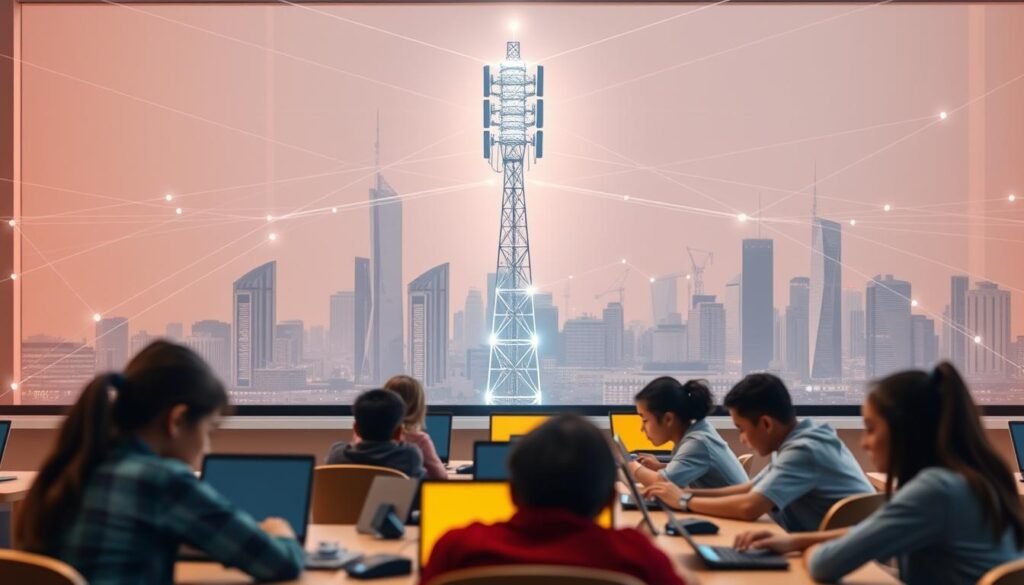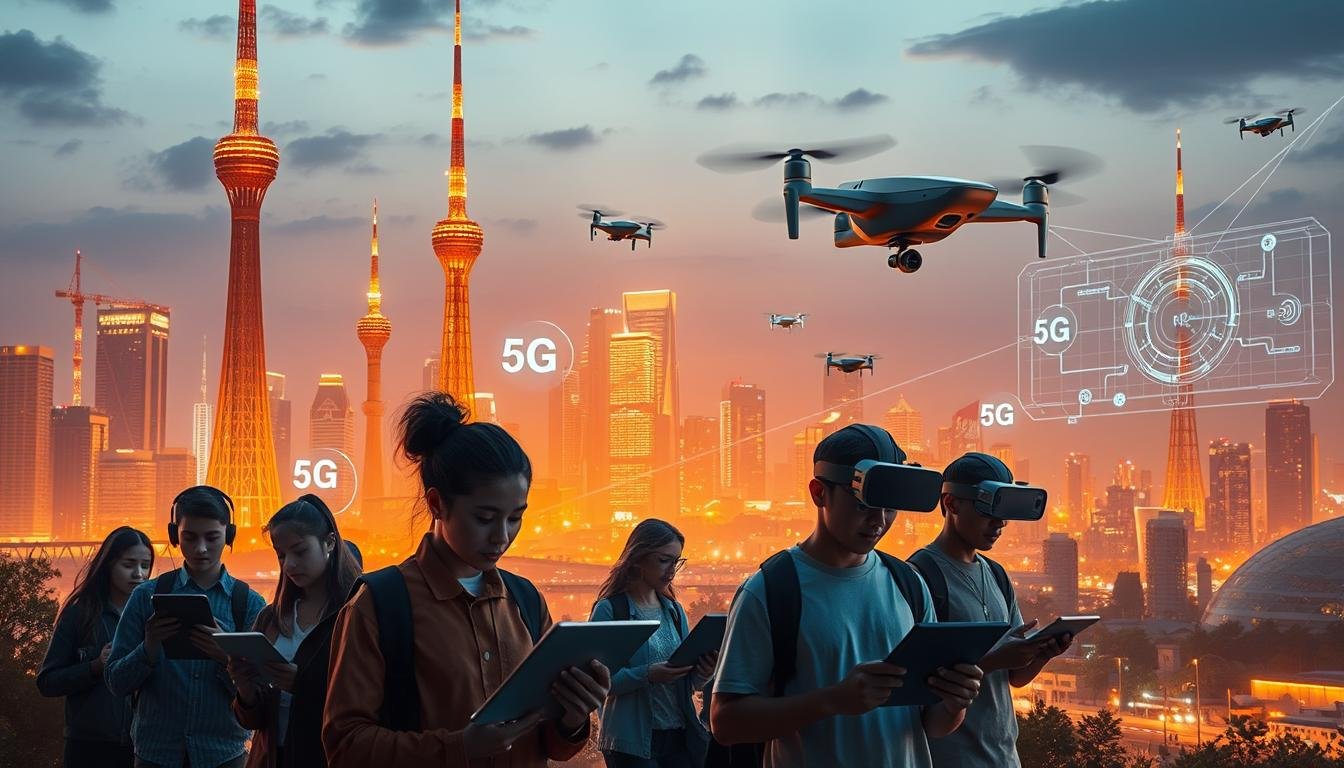Did you know that 5G technology can download an entire HD movie in less than 10 seconds? This lightning-fast connectivity is revolutionizing online learning experiences across the United States. It’s transforming how students engage with educational content. The impact of 5G on online learning is creating unprecedented opportunities for interactive and immersive educational experiences.
Students and educators are witnessing a remarkable shift in digital learning capabilities. 5G technology benefits extend far beyond simple internet speed, promising to reshape the entire educational landscape. From rural classrooms to urban learning centers, the potential for 5G to enhance online learning experiences is truly remarkable.
The integration of 5G technology brings unprecedented connectivity and interactivity to virtual learning environments. Students can now access high-quality educational resources, participate in real-time collaborative sessions, and explore immersive learning experiences that were previously impossible.
Key Takeaways
- 5G enables ultra-fast internet speeds for seamless online learning
- Enhanced connectivity supports more interactive educational experiences
- Technology breaks geographical barriers in education
- Real-time collaboration becomes more accessible
- Immersive learning technologies are now more feasible
- Skill development platforms gain powerful new
Introduction to 5G Technology
5G technology marks a significant advancement in wireless communication, reshaping our approach to online education and connectivity. It transcends basic internet access, opening up new avenues for digital learning experiences.
Its standout features include:
- Dramatically faster download and upload speeds
- Significantly reduced network latency
- Enhanced capacity for simultaneous device connections
- More reliable and stable wireless connections
The potential of 5G goes beyond traditional communication. Virtual education platforms are set to exploit these advancements, enabling virtual learning to reach new heights.
Unlike its predecessors, 5G networks can handle complex digital interactions with minimal delay. This means real-time collaboration, immersive learning, and effortless access to educational resources globally.
The future of education is wireless, interconnected, and incredibly fast.
The Current State of Online Learning
Online learning has profoundly reshaped education, offering new avenues and hurdles for both learners and educators. The digital classroom environment is in a state of continuous evolution, with technology at its core. It significantly influences the educational experiences of today.
Students encounter numerous hurdles in today’s online learning setting. The quality of 5G’s impact on distance learning hinges on several pivotal factors. These elements directly affect educational outcomes.
Persistent Challenges in Digital Education
- Unstable internet connections disrupting online classes
- Limited interaction between students and instructors
- Technical barriers preventing seamless learning experiences
- Inconsistent 5G network optimization across different regions
The Critical Role of Internet Speed
Internet speed has emerged as a critical necessity for effective online learning. Slow connections pose substantial obstacles to educational engagement. Therefore, 5G network optimization is essential for the advancement of educational technologies.
Students need dependable, high-speed internet for:
- Streaming educational content
- Participating in video conferences
- Accessing interactive learning platforms
- Downloading research materials swiftly
The advent of 5G technology holds the promise of transforming how students engage with educational content. It aims to overcome many of the current limitations in online learning platforms.
How 5G Revolutionizes Online Education
The digital learning landscape is undergoing a dramatic transformation with 5G technology. This represents a quantum leap in educational experiences, offering unprecedented connectivity and performance for students and educators alike.
5G speed for online learning is not just an incremental upgrade—it’s a complete reimagining of digital education. The ultra-fast network capabilities are breaking down traditional barriers to interactive and immersive learning environments.
Increased Internet Speeds: A Game Changer
The unprecedented speed of 5G networks brings remarkable advantages to online education:
- Download course materials in seconds
- Stream high-definition video lectures without buffering
- Support multiple simultaneous connections
- Enable complex multimedia learning platforms
Low Latency: Seamless Learning Experiences
5G’s minimal delay creates real-time interactive learning experiences. Students can now participate in virtual classrooms with crystal-clear audio and video, making remote education feel more engaging and personal.
The technology eliminates communication lags, ensuring smooth collaboration between students and instructors across different geographical locations. This breakthrough in connectivity is reshaping how we perceive distance learning.
Enhanced Interactive Learning Environments
5G technology is revolutionizing online education, creating immersive and dynamic learning experiences. Next-gen online learning with 5G opens up unprecedented opportunities for students and educators to interact in ways never before possible.
The power of 5G and virtual classrooms is transforming how students engage with educational content. Students can now experience learning environments that break traditional classroom boundaries.
Real-Time Feedback and Collaboration
5G enables instantaneous communication and collaboration through advanced digital platforms. Key benefits include:
- Seamless video conferencing with zero lag
- Interactive group projects across global locations
- Instant sharing of complex multimedia content
- Real-time collaborative document editing
Virtual and Augmented Reality Applications
Emerging technologies powered by 5G are creating immersive learning experiences. Students can now:
- Explore 3D scientific simulations
- Conduct virtual laboratory experiments
- Take interactive historical tours
- Practice complex medical procedures in safe environments
These innovations demonstrate how 5G is not just improving internet speed, but fundamentally redesigning educational interaction and engagement.
Accessibility and Inclusivity in Education
The advent of 5G is revolutionizing educational accessibility, dismantling long-standing barriers. It is opening up unprecedented opportunities for students from various backgrounds to participate in learning. This transformation is reshaping the educational landscape.
With 5G, virtual learning is being enhanced, paving the way for inclusive education. Students with different learning requirements can now access superior educational resources. This is irrespective of their geographical or physical constraints.
Bridging the Digital Divide
5G technology emerges as a potent solution to educational disparities. It employs several strategies to bridge the gap:
- It provides high-speed internet in rural and underserved areas.
- It reduces connectivity costs for economically disadvantaged students.
- It enables the use of affordable mobile learning platforms.
Supporting Diverse Learning Needs
The advanced features of 5G networks facilitate personalized learning experiences. Students with disabilities can now benefit from:
- Real-time translation services.
- Adaptive learning technologies.
- Interactive assistive learning tools.
By democratizing access to advanced educational technologies, 5G is fostering a more equitable learning environment. Here, every student has the chance to excel.
5G’s Influence on Mobile Learning

The educational landscape is undergoing a significant transformation, driven by 5G technology. This innovation is revolutionizing how students engage with educational content. Mobile learning has evolved, becoming more dynamic and accessible. It now offers unparalleled opportunities for students to interact with knowledge at any time and place.
Online education and 5G connectivity are forming a powerful synergy. This synergy enables learners to transcend traditional classroom limitations. Students can now access high-quality educational resources through mobile devices. These devices benefit from lightning-fast internet speeds and minimal disruptions.
Learning on the Go
5G technology grants learners unparalleled mobility and flexibility. Key advantages include:
- Seamless video streaming of lectures
- Real-time collaborative project work
- Instant access to massive educational databases
- Enhanced interactive learning experiences
Application Development for Mobile Learning
Innovative mobile learning applications are emerging, leveraging advanced educational technologies. Developers are crafting sophisticated platforms that cater to individual learning styles. These platforms offer personalized educational experiences that were previously unattainable.
The future of mobile learning appears incredibly promising, with 5G leading the way. It promises more immersive, interactive, and accessible educational experiences.
Data-Driven Insights for Educators
The advent of 5G technology is revolutionizing the way educators grasp and enhance student learning. It introduces unprecedented avenues for data-driven educational tactics, previously unattainable. This shift heralds a new era in educational support.
5G facilitates real-time data collection and analysis, offering a holistic view of student performance. This cutting-edge network technology enables immediate monitoring of learning progress, engagement, and individual student hurdles.
Enhanced Analytics for Student Performance
Thanks to 5G’s high-speed connectivity, educators can now access detailed learning analytics. These analytics unveil deeper insights into student behaviors and academic patterns. The insights include:
- Precise learning pace tracking
- Engagement measurement across different learning modules
- Immediate identification of learning gaps
- Personalized performance recommendations
Tailoring Curriculum with Data
The data generated by 5G-powered learning platforms empowers educators to craft adaptive and responsive curriculum strategies. By grasping individual student needs, teachers can devise targeted interventions and personalized learning paths. This approach maximizes educational outcomes.
As 5G continues to advance, the potential for data-driven educational insights expands exponentially. This promises a future of more intelligent, responsive, and effective learning experiences.
Security Considerations of 5G in Education

The advent of 5G technology in online classes heralds a new era of learning. However, this digital leap necessitates stringent security measures to safeguard student data and uphold trust in 5G network optimization strategies.
Cybersecurity has evolved into a pivotal aspect of contemporary educational platforms. As 5G speeds enhance digital interactions in online learning, educational institutions must deploy comprehensive protection protocols.
Protecting Student Data
Ensuring the security of student information demands a multi-faceted approach:
- Advanced encryption technologies
- Secure authentication mechanisms
- Real-time threat detection systems
- Comprehensive data privacy frameworks
Establishing Secure Online Platforms
Modern educational platforms employ state-of-the-art security technologies to foster secure digital learning environments. Intelligent network segmentation and continuous monitoring thwart unauthorized access, ensuring uninterrupted connectivity for students.
By emphasizing security in 5G-enabled educational ecosystems, institutions can foster trust, safeguard sensitive information, and foster robust online learning experiences. These empower students in a variety of digital environments.
Future Trends in Online Learning with 5G
The educational realm is undergoing a profound transformation with the advent of 5G technology. This next-generation online learning with 5G is poised to revolutionize the dynamics between students and educators within digital learning environments. As network capabilities advance, the scope for innovative educational experiences continues to broaden.
Predictive technologies are poised to redefine educational methodologies. The integration of artificial intelligence with 5G networks will facilitate personalized learning experiences that dynamically adjust to the unique needs of each student.
Emerging Predictive Learning Technologies
- AI-driven curriculum personalization
- Real-time performance analytics
- Adaptive learning platforms
- Intelligent tutoring systems
Global Classroom Expansion
5G and virtual classrooms are dismantling geographical constraints. Students can now access top-tier education from anywhere, connecting with global experts and peers effortlessly. This technology empowers:
- Immersive cross-cultural learning experiences
- Global collaborative projects
- Virtual exchange programs
- Instant multilingual translations
The future of education is borderless, intelligent, and deeply connected. As 5G continues to evolve, we anticipate even more groundbreaking learning experiences that were previously unimaginable.
Conclusion: Embracing 5G in Education
The advent of 5G technology marks a significant milestone in the realm of educational technology. It is revolutionizing digital learning platforms, offering unprecedented opportunities for both students and educators globally. The synergy between high-speed connectivity and innovative educational strategies is unlocking new avenues for interactive and immersive learning.
As educational institutions delve into advanced network analytics, the potential for personalized and adaptive learning becomes increasingly evident. Students can now access real-time resources, collaborate seamlessly across global platforms, and engage with cutting-edge educational technologies. The integration of 5G technology bridges critical gaps in traditional learning models.
Moving Forward with Innovation
Educators and institutions must proactively embrace these technological advancements to remain competitive in the evolving digital landscape. The future of learning demands flexibility, connectivity, and adaptive strategies that leverage 5G’s transformative capabilities. By investing in infrastructure and training, schools can create dynamic learning environments that prepare students for an increasingly digital world.
Preparing for the Future of Learning
Strategic implementation of 5G technology will be crucial for educational success. Students will benefit from enhanced interactive experiences, improved accessibility, and more personalized learning approaches. As technology continues to advance, the educational sector must remain agile, innovative, and committed to leveraging these powerful tools to empower learners of all backgrounds.
